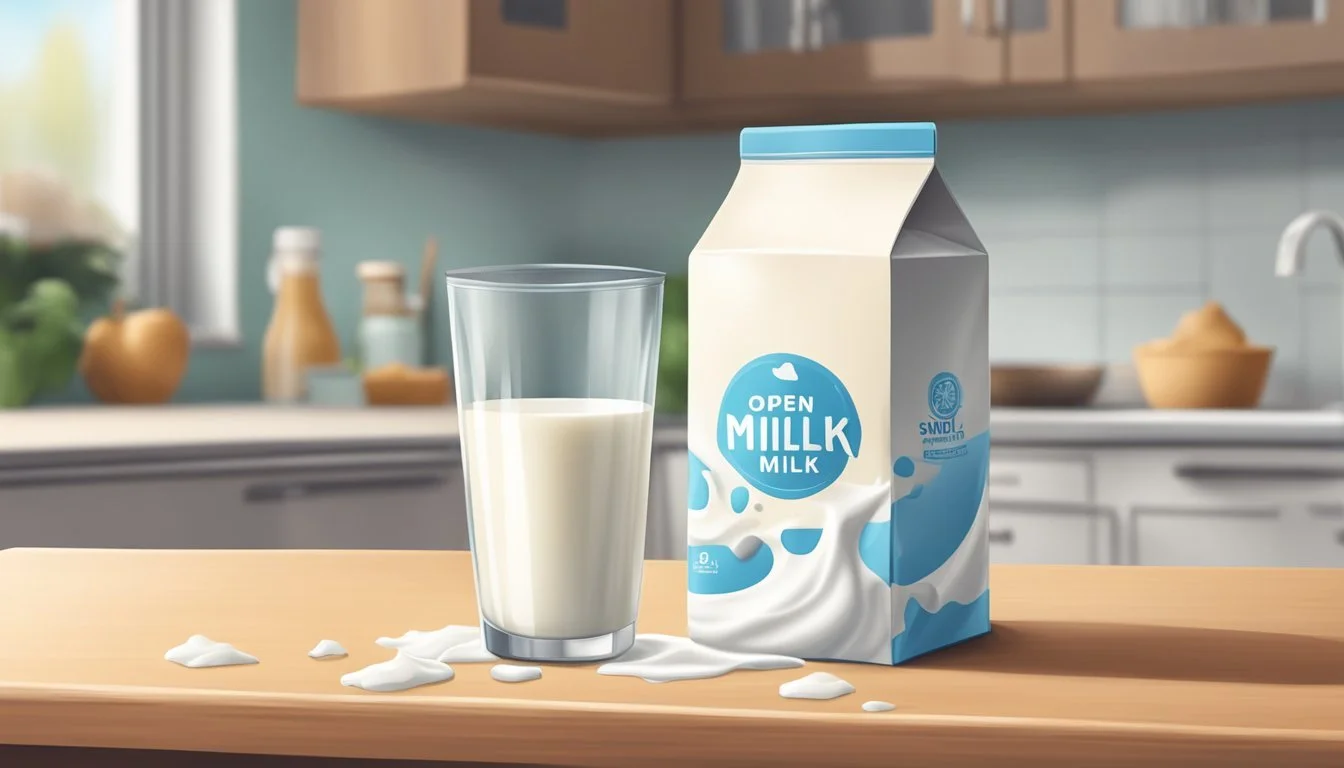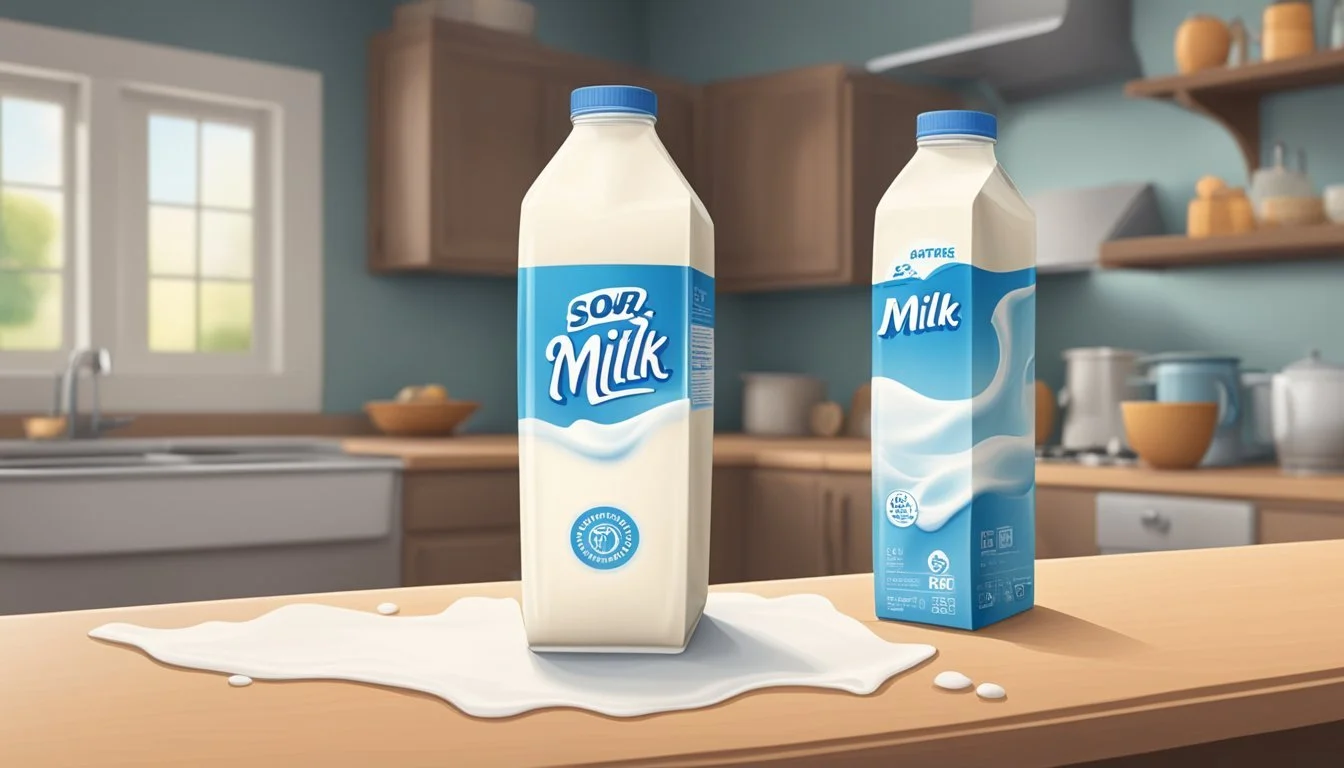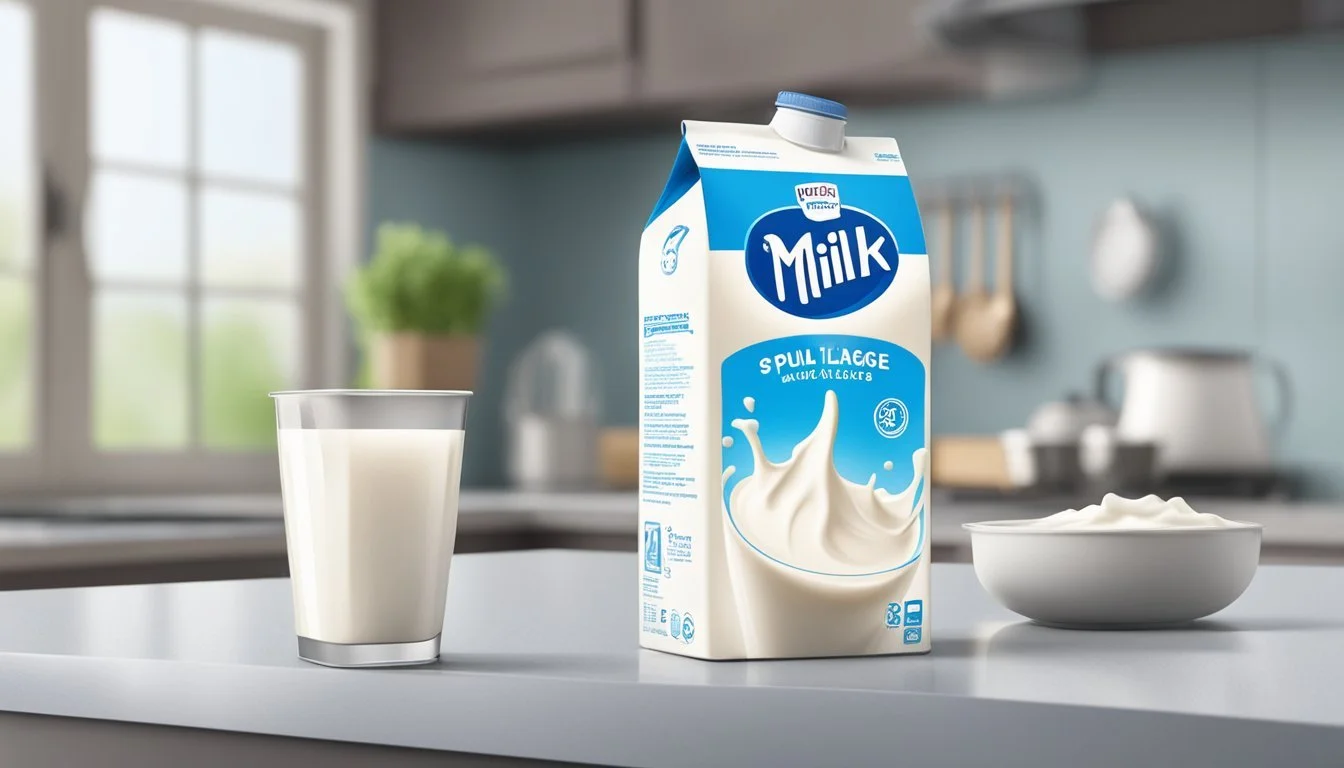Does Milk Go Bad?
Understanding Shelf Life and Spoilage Signs
Milk, a staple in many diets, is known for its nutrients and its role in healthy eating. It's rich in calcium, vitamin D, and proteins, making it a valuable component of a balanced diet. However, the freshness of milk is a topic of frequent inquiry among consumers who want to ensure they are drinking safe and pleasant-tasting milk. The crux of the matter is that milk can go bad, and its shelf life varies depending on a number of factors including how it is processed and stored.
The 'sell-by,' 'use-by,' or 'expiration' dates found on milk cartons give consumers an indication of the milk's expected freshness period. Although these dates are not absolute indicators of spoilage, they help gauge how long milk might maintain its best quality. Milk is generally consumable for several days past the labeled date as long as it's been refrigerated properly. Room temperature accelerates milk spoilage, so maintaining a cool and constant refrigerator temperature becomes key to preserving its freshness.
Identifying spoiled milk is straightforward: a sour smell and curdling are telltale signs it's time to discard the product. The souring of milk occurs due to the growth of bacteria that are naturally present in dairy, which proliferate more swiftly when milk is not stored correctly or as it gets older. It's essential to rely on one's senses to assess milk quality before consumption—regardless of the dates printed on the packaging.
Understanding Milk Composition
Milk composition is crucial in determining both its nutritional profile and how it may ultimately spoil or degrade. Milk is a complex liquid comprising various components—including proteins, lactose, fats, vitamins, and minerals—that contribute to its stability and health benefits.
Protein and Lactose Content
Milk proteins are primarily casein and whey, constituting about 3.2% of milk's composition. Proteins are vital for their nutritional value and their role in the structure and stability of milk. Lactose, a sugar that amounts to around 4.7% of the composition, is crucial for the palatability and energy content of milk. For individuals with lactose intolerance, alternatives like lactose-free or almond milk, which inherently lacks lactose, may be suitable options.
Fat Content and Varieties
The fat content in milk can vary: whole milk contains about 3.6% fat, lending it a richer flavor and creamier texture. Skim milk, with virtually all fat removed, offers a lower-calorie alternative. The presence of fats affects the taste, consistency, and nutritional density of milk. Fats are essential for the bioavailability of fat-soluble vitamins but are a consideration in caloric intake and dietary preferences.
Vitamin and Mineral Profile
Milk is enriched with a variety of vitamins and minerals, including calcium, potassium, and vitamins A, D, and B complex. These components are integral to bone health and metabolic processes. The vitamin and mineral content can be influenced by the diet of the cow, such as whether they are fed pasture or concentrate-based diets. Milk alternatives like almond milk are often fortified to match the nutritional profile of dairy milk.
Spoilage Process of Milk
When it comes to milk spoilage, understanding the role of bacteria, the chemical changes during spoilage, and recognizing the signs of spoiling are key.
Bacterial Growth and Spoilage
Milk spoilage is predominantly caused by the growth of bacteria that survive the pasteurization process. These bacteria, including Lactobacillus species, thrive at warmer temperatures and can quickly proliferate, leading milk to spoil. They feed on the lactose in milk, producing lactic acid and other compounds detrimental to milk quality.
Chemical Changes in Spoiled Milk
Chemical changes in milk during spoilage include the increase of lactic acid, which contributes to the sour taste. Spoiled milk may undergo a decrease in pH due to this acidity. Other chemical indicators of spoilage are the breakdown of proteins and the formation of gases, which can lead to off-flavors and odors.
Signs of Spoiled Milk
Spoiled milk is identifiable by its distinct sour smell and taste. The texture also changes, often becoming thicker or developing lumps as it starts to curdle. Additionally, the color can change slightly. These changes indicate that the milk is no longer suitable for consumption.
Storage and Shelf Life
Ensuring milk retains its quality and safety involves proper storage techniques, understanding the impact of temperature, and recognizing the significance of expiration dates.
Proper Storage Techniques
Proper storage is pivotal in extending the shelf life of milk. One should always refrigerate milk at temperatures between 32°F (0°C) and 40°F (4°C), ideally in the main body of the refrigerator rather than in the door, where temperature fluctuations are more common. It's best to keep the milk in its original container to prevent exposure to light and odors, which can also affect freshness.
Do:
Refrigerate promptly after purchase.
Keep in the original packaging.
Store away from strong-smelling food items.
Don't:
Leave milk at room temperature.
Store in the refrigerator door.
Impact of Temperature on Milk
Temperature plays a crucial role in milk's shelf life. Milk should not be left out at room temperature. The "danger zone" for bacterial growth in perishable foods like milk is between 40°F (4°C) and 140°F (60°C). If milk is stored at a higher temperature, bacteria can grow more rapidly, thereby reducing the milk's quality and safety. A consistently cold temperature in the refrigerator helps to slow down bacterial growth and keep milk safe for consumption longer.
Expiration Date Relevance
The dates on milk containers are not an absolute indicator but are helpful guidelines. The use-by, sell-by, and best if used by dates are indicators of the product’s peak quality as estimated by the manufacturer. Milk is generally consumable for about 7 days after the expiration date if it has been stored correctly. After this point, milk may show signs of spoilage, such as an off smell or curdling, and should not be consumed.
Keep in Mind:
Sell-by date: Aim to purchase before this date.
Use-by/best if used by: Consume milk by this date for best quality.
Expiration date: Milk may last up to 7 days past this date, but check for spoilage signs.
Food Safety and Health Concerns
When milk spoils, it poses significant food safety risks. The consumption of spoiled milk, characterized by a sour smell and taste, can lead to food poisoning symptoms such as nausea, vomiting, and diarrhea. Careful handling and storage are therefore crucial for dairy safety.
Symptoms of Dairy-Related Food Poisoning
Individuals who consume spoiled or contaminated milk may experience a range of symptoms indicative of food poisoning. These include:
Stomach Pain: Onset of cramping or aching in the abdominal area.
Nausea: Feeling the urge to vomit, a precursor to vomiting.
Diarrhea: Frequent, loose, or watery stools that may occur abruptly.
Vomiting: The forceful expulsion of stomach contents through the mouth.
It is important to note that these symptoms can manifest within hours to days following the consumption of contaminated dairy products.
Notable Dairy Pathogens
Several pathogens are known to be associated with dairy-related illnesses, including:
Salmonella: Can cause gastrointestinal distress and is one of the more common pathogens found in dairy products.
Listeria: Known for being present in raw milk and raw milk products. This bacterium can lead to severe illness, especially in the most susceptible populations such as pregnant women, the elderly, and those with weakened immune systems.
E. coli: Certain strains of this bacterium can cause food poisoning, often resulting in severe diarrhea and abdominal pain.
It is essential for consumers to recognize the risks associated with consuming raw or unpasteurized milk due to these bacteria. Food safety practices such as pasteurization are designed to eliminate these pathogens and reduce the risk of foodborne illness.
Pasteurization and Dairy Treatments
To ensure dairy safety and extend shelf life, pasteurization serves as a pivotal treatment process. This technique not only combats microorganisms but also influences the duration for which milk remains consumable when refrigerated.
Benefits of Pasteurization
Pasteurization is the heating of milk to a specific temperature for a set period. Primarily, it aims to prevent foodborne illnesses by destroying pathogenic microbes. Key benefits include:
Safety: It eradicates harmful organisms like Salmonella, E. coli, and Listeria, which can lead to serious health issues.
Shelf Life: Pasteurized milk, when kept refrigerated and unopened, can last significantly longer than raw milk.
Difference Between Pasteurized and Raw Milk
Safety: Pasteurized milk has undergone a heat treatment process to kill pathogens, making it safer for consumption than raw milk.
Shelf Life: Raw milk spoils more quickly than pasteurized milk. Pasteurized milk, especially when ultra-pasteurized, has a longer shelf life even when refrigerated.
Type of Milk Treatment Shelf Life when Refrigerated Raw milk None Shortest Pasteurized milk Heated to 161°F for 15 seconds Longer Ultra-pasteurized milk Heated above 161°F for very short time Longest
Once pasteurized milk is opened, it is exposed to bacteria that can cause it to spoil. It is recommended to consume the milk before the expired date and consume it soon after opening to ensure quality and safety.
Consumption Tips
When it comes to consuming milk, one must be vigilant about its freshness to ensure safety and quality. Key factors include proper assessment before use and responsible disposal if the milk is expired.
Assessing Milk Before Use
Before consuming milk, individuals should inspect the milk container for any signs of spoilage. The best approach is to rely on one's senses:
Smell: A sour or unpleasant odor is a clear indication the milk has gone bad.
Visual Inspection: Look for changes in texture, such as clumping or a yellowish color.
Taste: If the milk has passed visual and smell tests, a small sip can determine any off flavors. However, this should be the last resort, to minimize the risk of ingesting spoiled milk.
Milk that has been opened should be consumed more quickly, as exposure to air can accelerate spoilage.
Discarding Expired Milk Safely
Managing food waste responsibly involves the appropriate disposal of expired milk. The following points should be followed:
Check the Date: Look at the expiration date on the package. If milk is past this date, proceed with caution and conduct a sensory evaluation.
Pour it Out: If milk is deemed unfit for consumption, pour it down the sink to prevent any potential for foodborne illness.
Recycle the Container: Rinse the milk container and recycle if possible, to minimize environmental impact.
Remember that while milk can sometimes be safe to drink a few days after the expiration date, one should not rely solely on the date as the definitive measure of safety.
Extended Use of Milk
Milk's usability extends beyond its freshness date through culinary adaptations and preservation techniques. There are viable options to reduce waste and enjoy milk in various forms, even when fresh milk is no longer an option.
Using Sour Milk in Recipes
Sour milk can be a substitute for buttermilk in recipes due to its similar acidity levels. It can be used in baked goods like pancakes, muffins, or scones to create fluffiness and a tender texture. When milk shows signs of spoilage like sour odors or slight thickening, but no visible mold, it might still be used in cooking. However, one should never use milk that smells extremely unpleasant or has developed an off-color.
Pancakes: Replace buttermilk with an equal amount of sour milk.
Baked Goods: Add sour milk in place of regular milk to add tenderness.
Freezing Milk for Later Use
Milk can be safely frozen to extend its shelf life, which is helpful if there's more milk on hand than can be used before it spoils. To freeze milk, it should be poured into an ice cube tray or left in its original container, allowing some room for expansion.
Storage: Use an airtight container or freezer-safe bag.
Thawing: Place the milk in the refrigerator for a day before use.
Shelf Life: Thawed milk should be consumed within a few days.
By following these methods, consumers can make the most out of their milk, reducing waste and exploring alternative uses.
Milk Alternatives and Their Shelf Life
Milk alternatives offer lactose-free options for those seeking dairy-free beverages, each with its own shelf life contingent on storage conditions and processing methods.
Non-Dairy Milk Varieties
Almond Milk: It generally has a shelf life of seven to ten days after opening. Unopened, it can last several months when stored at room temperature, given its shelf-stable nature provided by UHT pasteurization. It is a popular choice for those looking to lower their cholesterol and carbohydrate intake, as well as those with lactose intolerance.
Soy Milk: Similar to almond milk in terms of shelf stability, soy milk once opened should be used within five to seven days. Unopened, it can last beyond the date printed on the package if stored properly in a cool, dry place.
Oat Milk: Although manufacturers often recommend consuming oat milk within seven to ten days post-opening, it can remain safe to consume for a few days beyond this range. An unopened carton can stay shelf-stable for several months.
Shelf Stability of Plant-Based Milk
Shelf stability in plant-based milks is achieved through ultra-high-temperature (UHT) pasteurization, where the milk is heated at high temperatures for a short period and then rapidly cooled. This process also allows unopened plant-based milks to remain shelf-stable without refrigeration until their expiration date. However, once opened, these alternatives should be stored in the refrigerator and consumed within the suggested time frame to ensure safety and freshness.
Storing Plant-Based Milks: After opening, refrigeration is necessary, and these milks should ideally be kept at the back of the fridge where the temperature is most consistent.
Shelf-Stable Packaging: Look for aseptic, non-refrigerated packaging for extended shelf life in unopened condition. Once opened, refrigerate and consume within approximately one week.
Understanding Milk Packaging
Selecting the right packaging for milk not only maintains its freshness but also guards against spoilage. It plays a pivotal role in the protection against external influences and in the extension of shelf life.
Types of Milk Packaging
Milk packaging varies extensively to meet both consumer needs and shelf-life requirements. Historically, glass bottles were the go-to for milk packaging, favored for their inertness and ability to be sanitized and reused. However, the modern dairy industry has seen a shift towards a variety of containers, each serving different purposes.
Plastic Containers: Commonly made from high-density polyethylene (HDPE), these are lightweight and cost-effective. Brands often choose these containers for commercial milk due to their convenience.
Cartons: Composed of paperboard and lined with a plastic layer, cartons are another prevalent choice. They offer a balance of protection and reduced weight.
Bagged Milk: This option is popular in some regions and uses minimal packaging, often appealing to cost-conscious consumers.
Each type of packaging is designed to ensure consistency and prevent the milk from drying out while protecting it from bacteria growth.
The Role of Light and Air Exposure
Milk's shelf life is greatly affected by light and air exposure. Two key components that can lead to spoilage are:
Light Exposure: Milk exposed to light can undergo a process called photodegradation, which not only affects nutritional value but can also lead to off-flavors.
Air Exposure: Oxygen can support the growth of aerobic bacteria and accelerate spoilage.
The industry responds to these issues by employing containers that act as barriers:
Packaging Type Light Blocking Air Sealing Plastic Containers Moderate Excellent Glass Bottles Varies* Excellent Paper Cartons Good Excellent Bagged Milk Low Good
*Clear glass bottles do not block light but tinted glass offers improved protection.
Both manufacturers and homemade milk suppliers must consider the implications of light and air in their packaging designs. While ensuring the milk remains safe to consume, the optimal packaging should also reduce the presence of bacteria and maintain the product's freshness until the designated expiration date.






